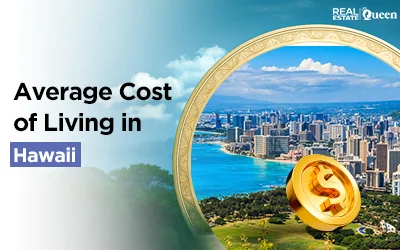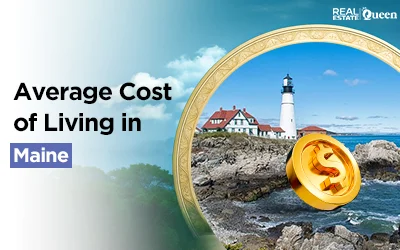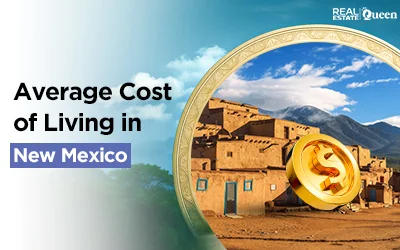
Considering a move to Hawaii? With its diverse economy and vibrant regions like Honolulu, Maui, and the Big Island, Hawaii offers a unique island lifestyle. However, the average cost of living in Hawaii in 2025 is notably higher than in many other states.
The cost of living index stands at 186.9, meaning it is about 87% more expensive than the US average. Therefore, it is essential for newcomers to understand the full expense picture. Here’s a closer look at what expenses to expect across housing, utilities, and more in Hawaii.
TL;DR: Average Cost of Living in Hawaii 2025
- Cost of Living Index: 186.9 (Highest in the US)
- Average rent: $2,668/month (81% higher than Oregon)
- Median home price: $975,500 (87% higher than Oregon)
- Average required salary: $80,729/year for middle-class lifestyle
- Electricity rate: 38.25¢/kWh (highest among peer states)
- Food & groceries: 20-30% above national average
- Healthcare spending: $11,000/year per household
- Fuel prices: Over $4.00/gallon
What Is the Average Cost of Living in Hawaii?
The average cost of living in Hawaii in 2025 requires a salary of about $80,729 per year to maintain a middle-class standard. This figure is far higher than in Oregon or Florida, where the required salary averages $55,000 and $53,000, respectively.
This increase reflects Hawaii’s premium housing, utilities, and everyday expenses. Meanwhile, the higher costs also highlight the island’s unique challenges with imports, transportation, and limited land availability.
Key monthly expenses include housing, utilities, food and groceries, transportation, and healthcare.
Housing and Rental Market in Hawaii
Hawaii’s housing market remains the biggest factor driving up the state’s average cost of living. The average rent is $2,668 per month, while the median home price stands at $975,500.
Comparatively:
- vs. Oregon: 81% higher rent, 87% higher home price
- vs. Florida: 36% higher rent, 126% higher home price
- vs. California: 16% higher rent, 13% higher home price
- vs. New York: Rent is slightly lower, but home prices are 55% higher
- vs. Alaska: Rent is around 80% higher, and homes cost more than double
In Honolulu, demand remains strong, keeping prices steep. On the other hand, Maui and the Big Island offer some relief but still cost more than many mainland markets.
👉 Looking for homes for sale in Hawaii that match your budget? Discover the latest listings with advanced search filters and sorting options on Houzeo, America’s best home buying website.
Utilities and Everyday Expenses in Hawaii
Utility costs, especially electricity, are among the highest nationwide. The average rate is 38.25¢ per kWh, more than double that of California and nearly triple that of Oregon or Florida.
Comparative electricity rates:
- California: 30.11¢/kWh
- Oregon: 13.69¢/kWh
- Florida: 13.42¢/kWh
- New York: 24.13¢/kWh
Additionally, food and groceries cost 20–30% more than the US average due to import reliance. Fuel prices remain over $4.00 per gallon, raising transportation costs. In addition, healthcare expenses average around $11,000 per household each year—similar to costs in California and New York.
Income and Job Market Overview in Hawaii
A salary of about $80,729 is needed for a middle-class lifestyle. Meanwhile, comparable states like Oregon, Florida, and Alaska require roughly $25,000 less. California and New York salaries fall slightly below Hawaii’s threshold, ranging between $70,000 and $75,000 annually.
As a result, job seekers should target positions with remote flexibility, competitive pay, and strong benefits to offset the high costs of island living.
Is It Worth Living in Hawaii Despite the Costs?
Living in Hawaii offers unmatched natural beauty, cultural richness, and a slower pace of life. However, the higher costs of housing and utilities require careful budgeting. For many, the balance between cost and lifestyle is a personal decision.
On the other hand, those who value community, outdoor recreation, and year-round sunshine often find the trade-off worthwhile.
Regional Insights and Relocation Tips
Honolulu serves as the state’s economic hub and has the highest prices. Meanwhile, Maui and the Big Island provide slightly more affordable options with smaller-town atmospheres. Still, all remain costly compared to most mainland states.
Newcomers should explore local housing programs, employment networks, and community forums to manage costs effectively.
Final Thought on Hawaii’s Cost of Living
In 2025, Hawaii remains the most expensive US state to live in. The average cost of living in Hawaii surpasses all peers due to high housing, electricity, and food prices. Nonetheless, its natural beauty and vibrant island culture continue to attract residents willing to adapt their lifestyles.
For those prepared to budget wisely, Hawaii offers not just a home, but a one-of-a-kind experience.
👉 Start your home search today by exploring the latest Hawaii homes for sale on Houzeo and discover neighborhoods that fit your budget and lifestyle.
FAQs About Hawaii’s Average Cost of Living
What is the average rent in Hawaii?
The average rent in Hawaii is around $2,668 per month, making it the highest among comparable states.
How much does a home cost on average in Hawaii?
The median home price in Hawaii is about $975,500, reflecting the state’s limited housing supply and strong demand.
What salary is needed to live comfortably in Hawaii?
You’ll need approximately $80,729 per year to maintain a middle-class lifestyle in Hawaii.






